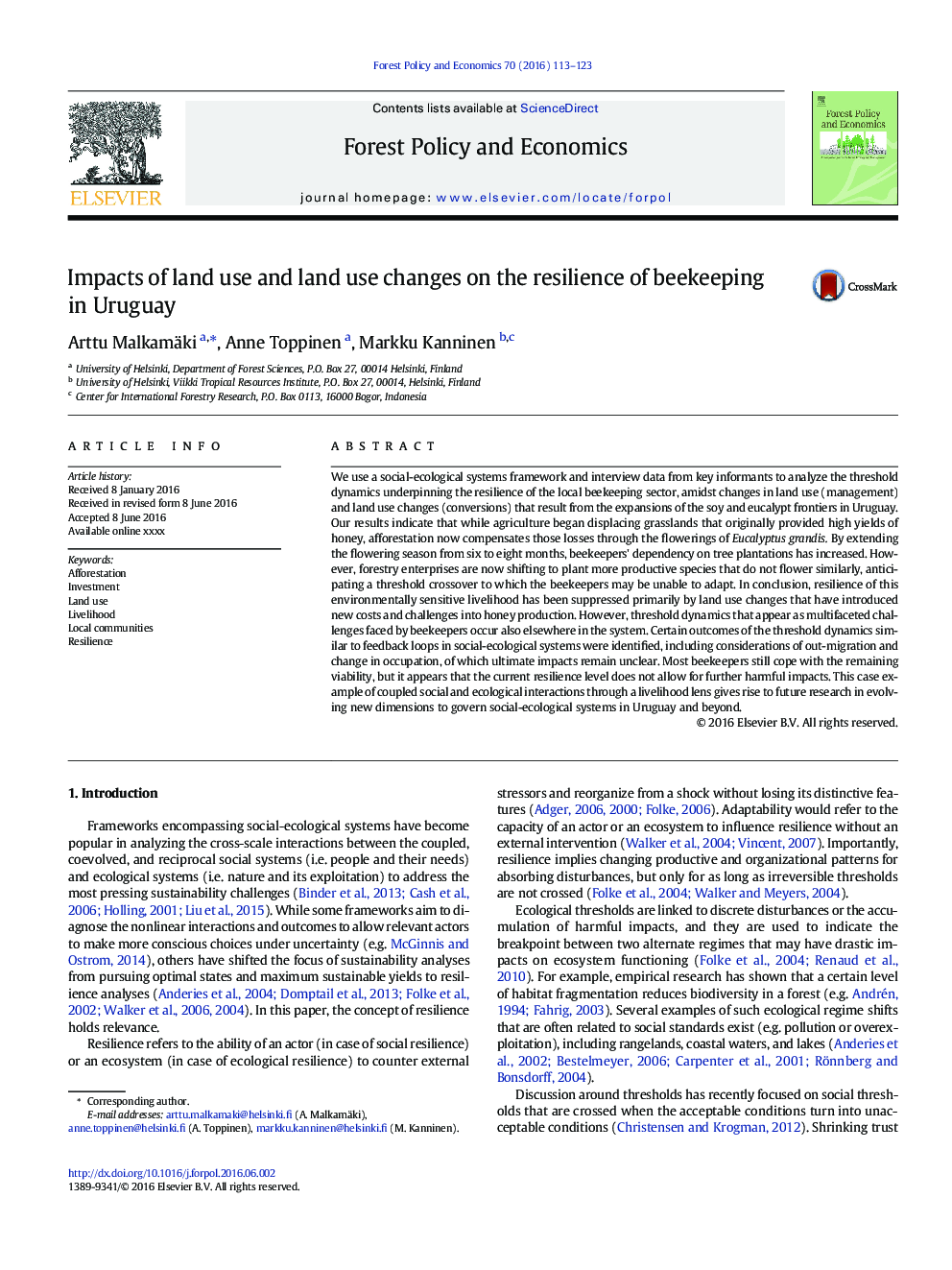| کد مقاله | کد نشریه | سال انتشار | مقاله انگلیسی | نسخه تمام متن |
|---|---|---|---|---|
| 6544875 | 159735 | 2016 | 11 صفحه PDF | دانلود رایگان |
عنوان انگلیسی مقاله ISI
Impacts of land use and land use changes on the resilience of beekeeping in Uruguay
ترجمه فارسی عنوان
تأثیرات استفاده از زمین و استفاده از زمین در انعطاف پذیری زنبورداری در اروگوئه تغییر می کند
دانلود مقاله + سفارش ترجمه
دانلود مقاله ISI انگلیسی
رایگان برای ایرانیان
کلمات کلیدی
جنگل زراعی، سرمایه گذاری، استفاده از زمین، معیشت، جوامع محلی، انعطاف پذیری،
ترجمه چکیده
ما از چارچوب سیستم های اجتماعی-محیطی و داده های مصاحبه ای از خبرنگاران کلیدی برای تجزیه و تحلیل پویایی آستانه که بر پایه انعطاف پذیری بخش زنبور عسل محلی است، در میان تغییرات در استفاده از زمین (مدیریت) و تغییرات استفاده از زمین (تبدیل) که ناشی از گسترش مرزهای سویا و اکالیپت در اروگوئه. نتایج ما نشان می دهد که در حالیکه کشاورزی شروع به جابجایی از علف های هرز شده بود که در ابتدا تولید عسل زیاد را به ارمغان آورد، جنگل زباله ها از طریق گل دهی اکالیپتوس گراندز را از بین می برد. با گسترش دوره گلدهی از شش تا هشت ماه، وابستگی زنبورها به مزارع درخت افزایش یافته است. با این حال، شرکت های جنگلی درحال تغییر به تولید گونه های تولیدی بیشتری هستند که به طور مشابه گل نمی خورند و پیش بینی می شود که یک متقاضی آستانه ای باشد که زنبورستان قادر به انطباق آن نیست. در نتیجه، انعطاف پذیری این معیشت حساس به محیط زیست، عمدتا از طریق تغییرات استفاده از زمین است که هزینه ها و چالش های جدید را به تولید عسل معرفی می کنند. با این حال، دینامیک آستانه ای که به نظر می رسد چالش های چند وجهی بوسیله زنبوران ظاهر می شود نیز در جاهای دیگر سیستم رخ می دهد. برخی نتایج از پویایی آستانه شبیه به حلقه های بازخورد در سیستم های اجتماعی-اکولوژیکی، از جمله ملاحظات مهاجرت خارج و تغییر در اشغال، که تاثیرات نهایی هنوز مشخص نیست. بسیاری از زنبورداران هنوز با زنده ماندن باقیمانده مواجه می شوند، اما به نظر می رسد که سطح فعلی انعطاف پذیری، تاثیرات مضر بیشتری را به بار نمی آورد. این نمونه موردی از تعاملات اجتماعی و زیست محیطی با استفاده از یک لنز معیشت، پژوهش های آینده را در حال تکامل ابعاد جدید برای مدیریت سیستم های اجتماعی-محیطی در اروگوئه و فراتر از آن انجام می دهد.
موضوعات مرتبط
علوم زیستی و بیوفناوری
علوم کشاورزی و بیولوژیک
جنگلداری
چکیده انگلیسی
We use a social-ecological systems framework and interview data from key informants to analyze the threshold dynamics underpinning the resilience of the local beekeeping sector, amidst changes in land use (management) and land use changes (conversions) that result from the expansions of the soy and eucalypt frontiers in Uruguay. Our results indicate that while agriculture began displacing grasslands that originally provided high yields of honey, afforestation now compensates those losses through the flowerings of Eucalyptus grandis. By extending the flowering season from six to eight months, beekeepers' dependency on tree plantations has increased. However, forestry enterprises are now shifting to plant more productive species that do not flower similarly, anticipating a threshold crossover to which the beekeepers may be unable to adapt. In conclusion, resilience of this environmentally sensitive livelihood has been suppressed primarily by land use changes that have introduced new costs and challenges into honey production. However, threshold dynamics that appear as multifaceted challenges faced by beekeepers occur also elsewhere in the system. Certain outcomes of the threshold dynamics similar to feedback loops in social-ecological systems were identified, including considerations of out-migration and change in occupation, of which ultimate impacts remain unclear. Most beekeepers still cope with the remaining viability, but it appears that the current resilience level does not allow for further harmful impacts. This case example of coupled social and ecological interactions through a livelihood lens gives rise to future research in evolving new dimensions to govern social-ecological systems in Uruguay and beyond.
ناشر
Database: Elsevier - ScienceDirect (ساینس دایرکت)
Journal: Forest Policy and Economics - Volume 70, September 2016, Pages 113-123
Journal: Forest Policy and Economics - Volume 70, September 2016, Pages 113-123
نویسندگان
Arttu Malkamäki, Anne Toppinen, Markku Kanninen,
